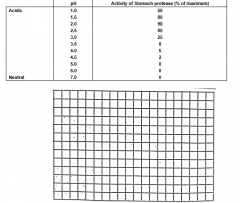![]()
![]()
![]()
Use LEFT and RIGHT arrow keys to navigate between flashcards;
Use UP and DOWN arrow keys to flip the card;
H to show hint;
A reads text to speech;
4 Cards in this Set
- Front
- Back
|
1. Ulcerative colitis causes inflammation of the lining (mucosa) of the large intestine or colon. The inflammation is usually located in the rectum and lower colon but may involve other parts of the colon and sometimes even the entire colon. Tiny open sores or 'ulcers' form on the surface of the lining and these may bleed. The inflamed lining also becomes thicker and produces a larger than normal amount of intestinal lubricant or mucus.How is this disease likely to affect the normal functioning of the large intestine (colon)? |
- |
|
|
2. Cystic fibrosis or CF is an inherited disease of the secretory glands. Secretory glands include glands that make mucus and sweat.CF mainly affects the lungs, pancreas, liver, intestines, sinuses, and sex organs.Mucus is a substance made by tissues that line some organs and body cavities, such as the lungs and nose. Normally, mucus is a slippery, watery substance. It keeps the linings of certain organs moist and prevents them from drying out or getting infected.When people have CF, the mucus becomes thick and sticky. It builds up in the lungs and blocks airways, often leading to serious lung infections. The thick, sticky mucus also can block the ducts in the pancreas which lead to the small intestine. (a) What affect will this blockage have on individuals with CF (b) CF also causes infertility in men, and the disease can make it harder for women to get pregnant. Suggest reasons for the infertility. |
- |
|
|
3. On the grid provided plot the activity of the enzyme (a stomach protease) against pH, using the data given in the following table |

(a) From the graph, determine the pH at which the enzyme is most efficient. * Mark this on the graph. (b) Give the pH range at which the enzyme is active. |
|
|
Up to q 4 |
- |

